Why SuperMemo Trashes Any Note-taking System (Including OneNote and Evernote)
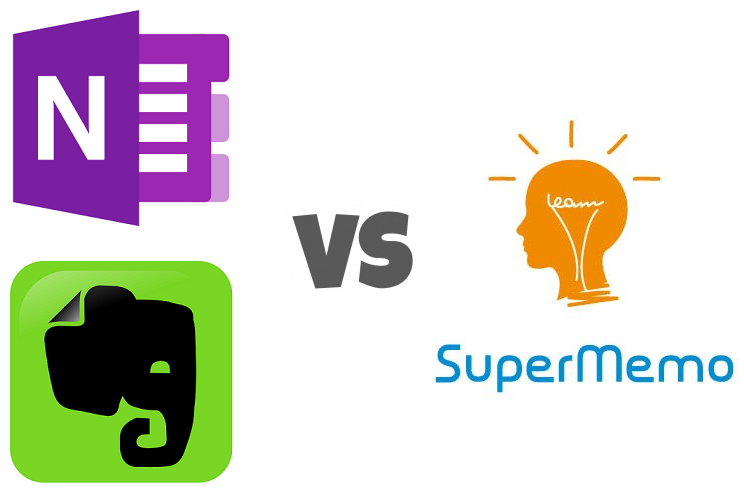
OneNote/Evernote: One-way interaction: you find and read information (your notes); it’s a personalized Wikipedia for indexing and organization
SuperMemo: Two-way interaction: information finds you; you turn information into knowledge
1. Intended uses of any note-taking system (summarization, highlighting and re-reading)
Another similar discussion: 3 Fatal Reasons Why You SHOULDN’T Be Taking Notes When Studying
Two typical use cases:
You’re reading a textbook for your class. You write down a condensed version in OneNote/Evernote. After finishing your notes you re-read them “frequently” before exam (next week or month).
Another use case: you take notes for every book you read. You have a note collection for all the books you’ve read over the years. You review them frequently or “once in a while”.
What are the problems?
Two Critical Flaws in Any Note-taking System
The above two cases can be broken down into two components:
- Creating notes (by summarizing and highlighting)
- Reviewing notes (by re-reading)
1. Creating notes
Refer to the following table. Summarization and highlighting are not effective.
2. Reviewing notes
I. Re-reading is not effective
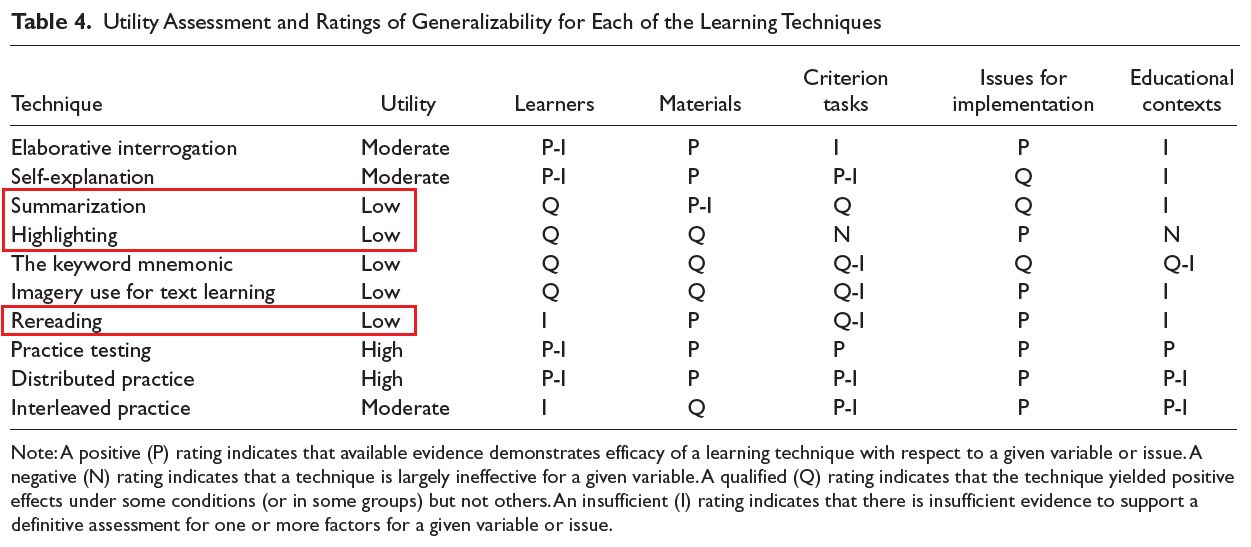
II. Unsustainable review schedule
“Review frequently” is unsustainable in the long-term. When your note collection grows, it’s impossible to maintain a re-reading review schedule. Most people are not aware that you need to review them. Even if they do, in most cases it’s “maybe two or three times” (in a year maybe?) There’s no review-schedule system.
For instance, you have 30 books in your “Book notes” collection, when are you going to re-read each book note? If you’re a dedicated learner, without a review-schedule system, you will have to manually keep track of all the review schedules. Perhaps you alert yourself (by some calendar notifications) to re-read your book notes. Since “reviewing sporadically” means more than one time, say 3 times: 30 books x 3 times = 90 calendar events. This is the equivalence of implementing a paper-and-pen Leitner system: how are you going to maintain 10,000 paper flashcards? It gets tedious and very quickly impossible when your note numbers grow. In most cases all of your notes just sit there collecting (digital) dust after its creation.
In Why Obsidian Will Overtake Roam ([6:12]), He said, “Evernote shaped me into being an undisciplined hoarder, recklessly collecting other people’s thoughts.”
Here’s how Ollie Lovell puts it:
So creating notes by summarizing and highlighting is ineffective (#1). Reviewing notes (through re-reading) is also ineffective (#2.1) while at the same time unmaintainable and unsustainable (#2.2). So any note-taking system provides very little value and mostly is just wasted effort. In most cases, any note-taking system is just that: it’s nothing more than an organized note collection.
Note-taking Systems (OneNote/Evernote) vs. SuperMemo
| OneNote/Evernote | SuperMemo | |
|---|---|---|
| When to review | Manual | Automatic |
| Interaction | Passive | Active |
| Goal | an end in itself | launchpad for flashcards |
1. When to Review
Scheduling when to review:
Any note-taking system: manually look for the information for review. But this brings up the problem with meta-judgment:
You don’t know. We don’t know what we don’t know and what we need to know. Gwern’s Spaced Repetition for Efficient Learning captures this paradox:
SuperMemo: Automatic scheduling for review (distributed practice): Algorithm to feed me the information based on priority queue and feedback
Distributed practice means a definitive review schedule: spacing your review schedule across weeks and months for a particular book note. Distributed practice only concerns with the when, not the how. In other words, even if you’re having none of the “flashcard-recall nonsense” and do zero active recall, SuperMemo will schedule EACH of your book note for re-reading weeks or months into the future. This avoids the “unsustainable manual review schedule” problem above.
Passive: Having a list of bookmarked websites or a seemingly-not-ending reading list.
Active: Importing them into SuperMemo so that they will show themselves in the future.
In any note-taking system you have to look for the information. In SuperMemo the information looks for you.
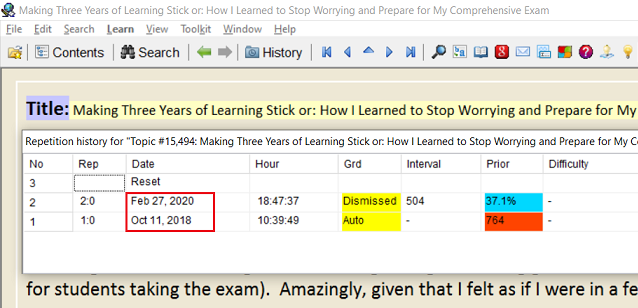 Reading an article I imported into SuperMemo over a year ago.
Reading an article I imported into SuperMemo over a year ago.
2. Interaction (Passive vs. Active)
Any note-taking system: Passive interaction
As I mentioned in the above “Two Critical Flaws in Any Note-taking System”: Summarizing is not passive but highlighting and re-reading are passive.
In a note-taking system, you don’t actively maintain your information. You don’t do active recall with it. Mostly you don’t rewrite, expand, elaborate or modify the content. All you have are pieces of digital notes laying there.
SuperMemo: Active interaction
In SuperMemo, you have an outstanding queue. Think of it as a conveyor belt: you are fed with your information. They are coming to you. For each piece of information you have to actively maintain it:
For Topics (Articles) (Incremental Reading):
-
Ignore it by pressing Next (i.e., read another time)
-
Delete it (no longer needed)
-
Read it and then decide to:
I. Extract important bits
II. Set Reading Point (Ctrl + F7) if you’re not finished
For Items (flashcards):
- Recall the answer and provide grading feedback:
-
Failed recall: (automatic schedule to try again)
-
Successful recall: SuperMemo schedules it weeks, months, or years into the future
-
Rephrase, condense, remove unnecessary bits
-
Delete it
Do you see how much more interaction you have with SuperMemo than a note-taking system? Maybe you can do all these manually in a note-taking system, but it’s not “part of the standard practice”, the critical flaw being the lack of a review-schedule system. The typical use case, as I mention above, is “summarize and re-read it once or twice”.
Any note-taking system: You do something TO it. SuperMemo: You play with it.
Anki is in the middle between a note-taking system and SuperMemo:
Anki has the active recall component for items but no measure to deal with the source/notes (Incremental Reading). Without a scheduling algorithm for the source materials (Incremental Reading), you’ll most likely to batch import all of you notes into Anki and then make flashcards out of them at one time.
3. The goal of taking notes (An end in itself vs. Launchpad for flashcards)
Any note-taking system: An end in itself: Taking notes is the end goal
SuperMemo: For further processing (turning into flashcards)
The end goal of taking notes is not about having a polished set of summarized, highlighted and re-organized notes for passive review later. If you think taking notes means “having already gained the knowledge”, you’re in for a rude awakening. For example, Google is a massive information library, but having access to knowledge doesn’t mean gaining the knowledge. By the same token, you have access to a personalized materials… and it is just that. It doesn’t mean you’ve learned it.
If taking notes should not be the end goal, then what is?
It’s a launchpad for the next step: turning relevant information into testable materials (aka flashcards). You break down all the information into testable chunks so that you can test yourself. In this perspective, taking notes is about gathering relevant information for flashcards. The goal of taking notes should be making flashcards out of them. People think taking notes is an end in itself. No, it’s a means to the next step:
Learning sources (lecture PDFs, tutorial videos, reading materials) –> take notes –> flashcards
Incremental Reading: Take notes from the source –> extracts into flashcards
Taking Notes is About Selecting Relevant Information
In terms of the SOI-model from Learning as a Generative Activity: Eight Learning Strategies that Promote Understanding, taking notes is mostly about the first step, the S: Selecting relevant information from sensory memory (from the instruction (your learning material)).
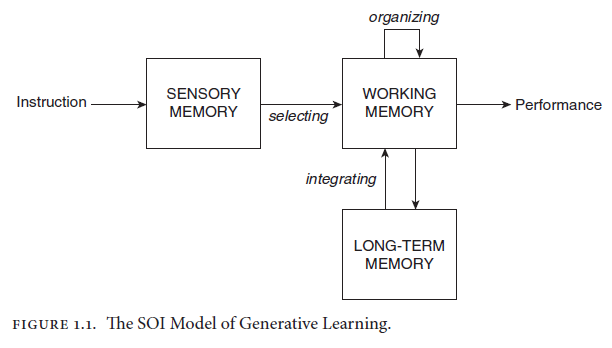
Taking notes is just a means to capture the information that you find important or relevant. For example, the notes you take for an important exam will be much different than the one you take from leisure reading. What you’re going to do with the captured information is another story.
Why flashcards?
Take another look at the above table. Flashcards is the direct application of practice testing (high utility), distributed practice (high utility) and interleaved practice (moderate utility). The best way to implement these learning strategies is through flashcards; the best way to use flashcards… you guess it, is through SRS (SuperMemo/Anki).
Knowledge Management in a Note-taking System is Just Busywork
Before SuperMemo, I was using OneNote. I had folders and sessions and pages of notes, organized and tagged. Here’s a screenshot of my OneNote from 2016. It’s the notes I took for the book— Gasp! Make It Stick:
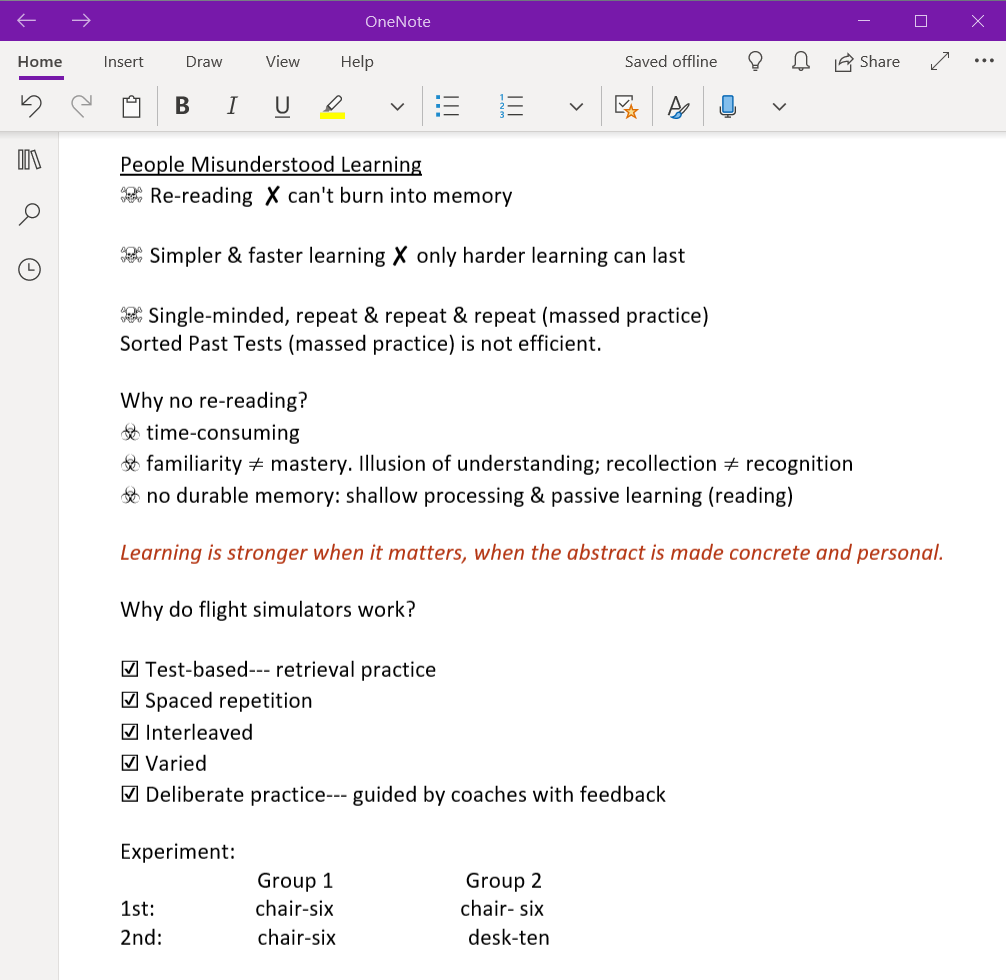
It’s true that OneNote (or Evernote) has a lot of functionalities that SuperMemo doesn’t have: synchronization, built-in OCR, modern and pretty UI design and interface, mobile version to “look up and review whenever and wherever you want”.
You can have the cleanest, most detailed, meticulously classified, instantly searchable, well-tagged and organized notes in a note-taking system, synchronized across all 5 devices. However, without the vital ingredient that is spaced retrieval practice (three points discussed above), it is pretty useless. All those are just bells and whistles because what matters is what you do with the information.
Any note-taking system is just a collection of blank pieces of digital paper that you can write on. There isn’t any inherent feature that promotes learning: active recall, distributed practice (scheduled to review later), feedback system to interact with your information. Without a rich interaction with your knowledge system, you’re more or less just a human version of Google indexing various information that is not knowledge.
You’re trashing on any note-taking system that is not SuperMemo.
I think they all belong to the same category (learning tools) so this comparison is not out-of-bounds (at least in my mind). SuperMemo is much more than a note-taking system, but nonetheless it also is a note-taking system. Besides, if there is one best learning strategy (there is), then any strategy that is not that, is sub-optimal. Refer back to the above utility assessment table:
SuperMemo:
Practice testing: ✔
Distributed practice: ✔
Interleaved practice: ✔
Only two techniques are rated high and SuperMemo (or Anki for that matter) has it.
Closing Remarks
At this point, I realized this discussion is a manifestation of our different beliefs about how to learn, in which it’s reflected in the tools we use:
Note-taking system: summarize and highlight from the source material; re-read “sporadically” or “frequently”
Spaced repetition software (SuperMemo/Anki): retrieval practice (active recall), distributed practice, interleaved practice
I’m not trashing on any particular note-taking system (OneNote or Evernote). To put it bluntly, I’m trashing on all note-taking systems. It’s just that the “standard practice” of note-taking is not useful or effective. By extension, the system that supports this goal is also not very useful and effective. To put it in another way, SuperMemo has completely revolutionized the way I think about learning, information and knowledge to the extent that now I think any note-taking system (OneNote or Evernote) is mostly useless.